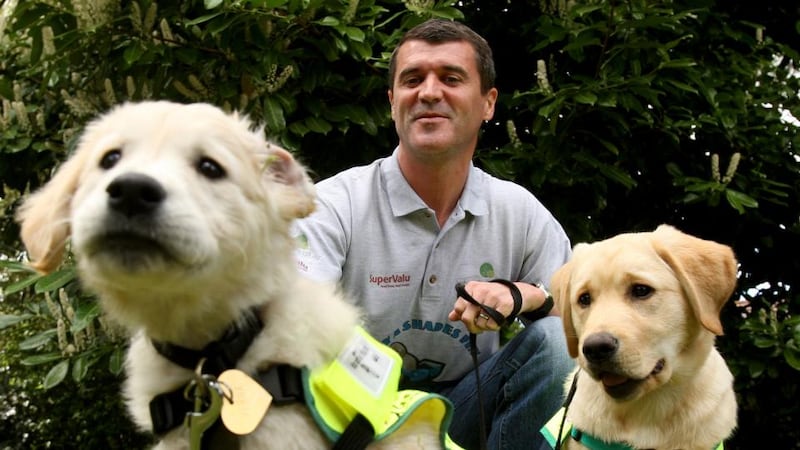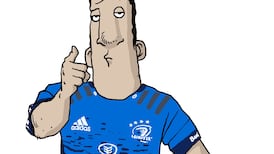“When I was young there was a place called the Blind Asylum in Cork, can you imagine that? People thought being blind was one of the worst things that could happen to another human being and so blind people were hidden away.”
But Jim Dennehy had no intention of hiding when he lost his sight in an accident in November 1968. His girls needed him.
Aged just 30, he was father to two-year-old Audrey and two-day-old Tara when he lost his vision. His wife, Pat, would learn of the news while in the maternity ward. Just months earlier Dennehy had won the second of his two Munster Senior Cup medals with Highfield and was previously capped by Leinster when studying in Newbridge.
Dennehy realised that blind people across Ireland, so limited in mobility and independence, would benefit as he did from having a guide dog
The owner of a successful motor trade business in Cork, Dennehy knew that standing still wasn’t an option and so, six months after losing his sight, the determined Cork man travelled to Torquay in the UK for mobility training at a rehab clinic.
He made good progress with the long cane.
But just before the programme concluded, he was taken to a guide dog centre in Exeter where he would encounter the four-legged wonders that would transform his life – and that of thousands of Irish people and their families.
“These dogs were amazing. I hadn’t really seen anything like it and so, there and then, I signed up to return for a course,” Dennehy explains.
Vanessa was his first dog, a pure white German Shepherd. “I’d say people in Cork didn’t know what to make of us walking down the street together,” he recalls.
Dennehy soon realised that blind people across Ireland, previously so limited in terms of mobility and independence, would benefit as he did from having a guide dog.
And so he set about testing the waters with Cork woman Mary Dunlop assisting. They held public meetings across the country where hundreds supported their plans to establish an Irish guide dogs service.
And so in 1976, after purchasing an old farm on the Model Farm road in Cork covering three acres, Jim, Mary and a team of volunteers set about converting old buildings into a mobility training centre and eventually the dogs arrived.
In 1980, the first two clients walked through the door.
“It took us those few years to get ready. This couldn’t be rushed. It was over a decade since I first encountered the guide dogs and, of course, it was a massive day for me when other blind people started to work with the dogs here in my home city,” recalls Dennehy.
Where others identified obstacles he sensed opportunity in those early days.
He and the team pushed on, trained more guide dogs and helped more people. And their work helped change the public’s perception of blindness and empower those with visual impairment.

But such innovation didn't come easily. Ireland during the 1980s was anything but flush yet somehow the association managed to raise enough funds to keep going.
“In 1996, there was a time when we thought we wouldn’t be able to pay the staff wages the following month. We didn’t know what to do, it didn’t look good. And then out of nowhere someone who passed away left us £250,000 in their will. Sure it saved us. The goodwill and generosity of people over the years has been nothing short of unbelievable,” explains Dennehy.
Key to that fundraising is the very visible and vocal support of Roy Keane.
“He’s been amazing for us. When he’s home in Cork he’ll always make time to come up to us and spend time with the dogs and with the staff. He really understands what we do and believes in it. We couldn’t have asked for a better person to be our ambassador. Like Roy always gives us a shout-out where he can. We appreciate that so much, he’s a great man.”
While it costs in the region of €5 million a year to run the Irish Guide Dogs for the Blind, only 15 per cent of funding comes via the State.
“Between 1976 and 1996, we didn’t get a penny from any government. We raised everything ourselves. It was when Brendan Howlin was minister for health that we first got some funding and we’re grateful for what we get but, of course, we’d like to get more. We’re doing well though. We’ve got a great team together and the future is very bright,” says Dennehy.
While the charity trains between 30 and 40 dogs each year in Cork, Dennehy would like to see that figure doubled, at least, in the years ahead.
“The demand for dogs across the country is massive. Don’t forget we also have dogs trained to work with autistic children. The impact of that relationship can be truly transformative. I’d love to see us train 80 dogs a year so that more people can feel the benefits.”
There was a time when the idea of a blind person going to university would be fanciful. Irish society didn't understand that someone with blindness could achieve so much
Now president of Irish Guide Dogs for the Blind, Dennehy has had four guide dogs himself over the years.
“After Vanessa, I had Ivan. He was a massive yellow Labrador. You’d see him coming a mile off and then I got, probably my best dog, Granby. He was black and a cross between a Labrador and a golden retriever. He was with me for a decade and was a wonderful dog. And my last dog was Bruno. All of them were amazing and I couldn’t imagine life without them all.”
Last week, Jim Dennehy was awarded an honorary doctorate from University College Cork in recognition of the hugely positive impact the charity he founded has had on service users.
“There was a time when the idea of a blind person going to university would be fanciful,” explains Dennehy.
“It just didn’t happen. Irish society didn’t understand that someone with blindness could achieve so much – and often times more than someone with vision. Now, here in UCC and other educational institutions across Ireland being fully or partially blind is not an impediment to learning. I’m so proud to now be among those other students who have achieved so much – not allowing anything to hold them back.”
After Dennehy collected his doctorate, a young student approached him to shake his hand and offer his congratulations. He had one hand outstretched . . . and the other holding his guide dog.











